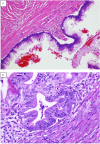How to differentiate primary mucinous ovarian tumors from ovarian metastases originating from primary appendiceal mucinous neoplasms: a review
- PMID: 40475008
- PMCID: PMC12138789
- DOI: 10.3389/pore.2025.1612066
How to differentiate primary mucinous ovarian tumors from ovarian metastases originating from primary appendiceal mucinous neoplasms: a review
Abstract
The accurate distinction between primary and secondary mucinous ovarian cancers is a crucial tool for effective surgical and systematic treatment. Mucinous ovarian metastases of appendiceal origin are a special group of tumors because they appear even in half of female patients with primary appendiceal mucinous carcinomas and demonstrate pathological similarity to primary ovarian mucinous neoplasms. The current literature review focuses on the differences based on pre-operative symptoms, radiological findings, the spectrum of microscopic features, and the significance of the immunophenotype of each tumor. Treatment options, including surgical management and adjuvant chemotherapy protocols, are also briefly overviewed. In conclusion, the source of the ovarian tumor mass might be suggested by preoperative symptoms, values of antigens, and imaging findings. However, the confirmation of the tumor origin is only made after the postoperative pathological examination. Investigating the most accurate immunohistochemical markers and new molecular features may improve diagnostic efficiency in future research.
Keywords: LAMN; primary mucinous ovarian cancer; pseudomyxoma peritonei; serum markers; tretment protocols.
Copyright © 2025 Kawecka, Pasnik, Adamiak-Godlewska, Semczuk, Tyczynska and Semczuk.
Conflict of interest statement
The authors declare that the study was conducted in the absence of any commercial or financial relationships that could be constructed as a potential conflict of interest.
Figures
Similar articles
-
Appendiceal mucinous neoplasms: controversial issues.Arch Pathol Lab Med. 2010 Jun;134(6):864-70. doi: 10.5858/134.6.864. Arch Pathol Lab Med. 2010. PMID: 20524864 Review.
-
Appendiceal mucinous neoplasm mimics ovarian tumors: Challenges for preoperative and intraoperative diagnosis and clinical implication.Eur J Surg Oncol. 2019 Nov;45(11):2120-2125. doi: 10.1016/j.ejso.2019.08.004. Epub 2019 Aug 20. Eur J Surg Oncol. 2019. PMID: 31462390
-
SATB2 is a supportive marker for the differentiation of a primary mucinous tumor of the ovary and an ovarian metastasis of a low-grade appendiceal mucinous neoplasm (LAMN): A series of seven cases.Pathol Res Pract. 2018 Mar;214(3):426-430. doi: 10.1016/j.prp.2017.12.008. Epub 2017 Dec 14. Pathol Res Pract. 2018. PMID: 29487003
-
Immunohistochemical characterization of appendiceal mucinous neoplasms and the value of special AT-rich sequence-binding protein 2 in their distinction from primary ovarian mucinous tumours.Histopathology. 2016 Jun;68(7):977-87. doi: 10.1111/his.12899. Epub 2016 Feb 2. Histopathology. 2016. PMID: 26542609
-
[Mucinous adenocarcinoma of the appendix associated with ovarian tumors and pseudomyxoma peritonei. The difficulty in differential diagnosis].An Med Interna. 2000 Oct;17(10):540-2. An Med Interna. 2000. PMID: 11109650 Review. Spanish.
References
-
- Yemelyanova AV, Vang R, Judson K, Wu LSF, Ronnett BM. Distinction of primary and metastatic mucinous tumors involving the ovary: analysis of size and laterality data by primary site with reevaluation of an algorithm for tumor classification. Am J Surg Pathol (2008) 32(1):128–38. 10.1097/PAS.0b013e3180690d2d - DOI - PubMed
Publication types
MeSH terms
LinkOut - more resources
Full Text Sources
Medical



